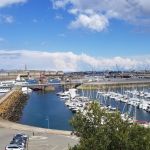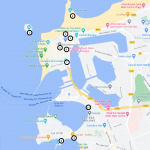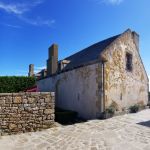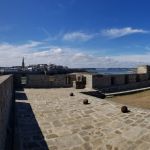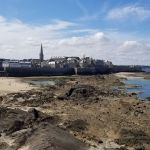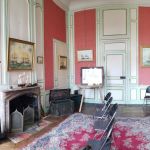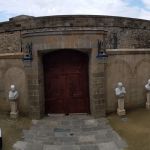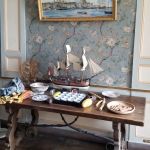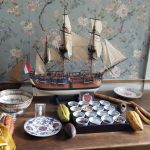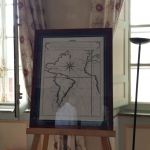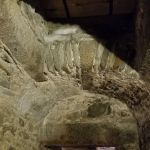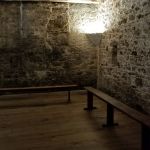Saint-Malo, known for one of the best privateers, is a small port city in Britany. With its tall city walls and its stone houses, the city really transports you to the Middle Ages.
City TourFort NationaleDemeure de Corsaire
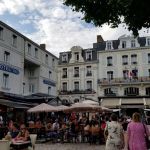
Walking in through the main entrance to the city, you will find the main city square. Lined with restaurants, the square is always busy with people relaxing and taking in the atmosphere.
![[Stop 1] Turning back around, you will see the Castle of the Dukes of Brittany, or as it is more commonly referred to: Castle of the Duchess Anne. As you walk around the city, you will see many things referring to Duchess Anne. She was highly respected by the Bretons as she followed in her father's footsteps in attempting to maintain the region's independence. By the time of her arranged marriages to not one but two kings of France, Charles VIII and Louis XII, Brittany had lost most of its independence but it has, to this day, maintained its right to fly the Brittany flag higher than that of the French. That liberty is largely credited to Duchess Anne.
<p>Built in the 15th century, the Castle today houses Town Hall and the City History Museum.</p>](https://www.ibafflatusdesign.space/wp-content/uploads/cache/2021/02/20200815_173126/2458974869.jpg)
[Stop 1] Turning back around, you will see the Castle of the Dukes of Brittany, or as it is more commonly referred to: Castle of the Duchess Anne. As you walk around the city, you will see many things referring to Duchess Anne. She was highly respected by the Bretons as she followed in her father's footsteps in attempting to maintain the region's independence. By the time of her arranged marriages to not one but two kings of France, Charles VIII and Louis XII, Brittany had lost most of its independence but it has, to this day, maintained its right to fly the Brittany flag higher than that of the French. That liberty is largely credited to Duchess Anne.
Built in the 15th century, the Castle today houses Town Hall and the City History Museum.
![[Stop 2] Saint Malo is one of the few cities that remain entirely surrounded by city walls. Taking a walk on the city walls makes it easy to get a feel for the city. From the city wall near the Quic-en-Groigne Tower of the Castle offers a good view of the birthplace of Chateaubriand, a famous French writer. It is today of course a restaurant and hotel, both accessible from the main square.](https://www.ibafflatusdesign.space/wp-content/uploads/cache/2021/04/20200815_124214/488222754.jpg)
[Stop 2] Saint Malo is one of the few cities that remain entirely surrounded by city walls. Taking a walk on the city walls makes it easy to get a feel for the city. From the city wall near the Quic-en-Groigne Tower of the Castle offers a good view of the birthplace of Chateaubriand, a famous French writer. It is today of course a restaurant and hotel, both accessible from the main square.

On the beach, two tidal islands are visible. There is evidence to suggest that the closer island, the Grand Bé was inhabited during the Prehistoric Era. There are also remains of a chapel and of the fortifications made by Vauban. Today, it serves as the location of Chateaubriand's grave.
![[Stop 3] Chateaubriand's grave is unmarked as the author expressed his desire to rest quietly on this island after his death to listen to the sea and the wind.](https://www.ibafflatusdesign.space/wp-content/uploads/cache/2021/04/20200815_104915/2434935447.jpg)
[Stop 3] Chateaubriand's grave is unmarked as the author expressed his desire to rest quietly on this island after his death to listen to the sea and the wind.
![[Stop 4] From the Grand Be, the National Fort is visible. Built on the orders of Louis XIV and designed by Vauban, the Fort has only been taken once: by the Germans during the Second World War. The objective of the Fort was to defend against recurring attacks by the English and the British. The most famous of those attacks came in 1693 when a Dutch-Anglo fleet sent a floating mine toward the city. The ship got stuck in the rocky floor and did no harm to the city or the surrounding forts.](https://www.ibafflatusdesign.space/wp-content/uploads/cache/2021/04/20200815_105329/3682157211.jpg)
[Stop 4] From the Grand Be, the National Fort is visible. Built on the orders of Louis XIV and designed by Vauban, the Fort has only been taken once: by the Germans during the Second World War. The objective of the Fort was to defend against recurring attacks by the English and the British. The most famous of those attacks came in 1693 when a Dutch-Anglo fleet sent a floating mine toward the city. The ship got stuck in the rocky floor and did no harm to the city or the surrounding forts.
![[Stop 5] The Saint-Vincent Cathedral of Saint-Malo is a Roman Catholic Cathedral built with a mix of Roman and Gothic styles.](https://www.ibafflatusdesign.space/wp-content/uploads/cache/2021/04/20200815_152950/1314842376.jpg)
[Stop 5] The Saint-Vincent Cathedral of Saint-Malo is a Roman Catholic Cathedral built with a mix of Roman and Gothic styles.
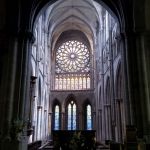
The church has a Latin cross footprint with a modern Great Rose window created in 1968 featured behind the altar.
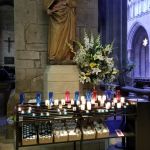
Originally placed in the niche above one of the city wall entrances, this marble statue of the Virgin Mary dates back from the 15th century. It is referred to as the Miraculeuse Protectrice de la Cité Malouine (that is the "Miraculous Protectress of the Malo City") due to the various legends about miracles it has performed.
![[Stop 6] Famous for its apple cider and crepes, Brittany boats many Creperies specializing in these foods. Saint Malo is no exception. Enjoy a bowl of cider at one of the creperies on the way to the next destination.](https://www.ibafflatusdesign.space/wp-content/uploads/cache/2021/02/20200815_174329/994916949.jpg)
[Stop 6] Famous for its apple cider and crepes, Brittany boats many Creperies specializing in these foods. Saint Malo is no exception. Enjoy a bowl of cider at one of the creperies on the way to the next destination.
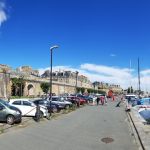
On the way to Stop 7, feel free to exit the city walls to get a sense of the imposing size of the city walls and the nautical feel of the city.
PS When you arrive at Stop 7: Demeure de Corsaire, switch over to the tab with the same name to get a closer look.
![[Stop 8] A short 20-minute walk along the water leads to the town of Saint-Servan, part of the Saint Malo commune. The most famous landmark of the town is the Solidor Tower. The name comes from two Britany words: <i>steir</i> and <i>dor</i> meaning the "gate of the river". During its initial use in the Middle Ages, the Tower was used to control traffic and control taxes from merchants hoping to get access to the sea. It has also served as a prison and is today the Museum of the Cape Sailors.](https://www.ibafflatusdesign.space/wp-content/uploads/cache/2021/04/20200816_114854/615841687.jpg)
[Stop 8] A short 20-minute walk along the water leads to the town of Saint-Servan, part of the Saint Malo commune. The most famous landmark of the town is the Solidor Tower. The name comes from two Britany words: steir and dor meaning the "gate of the river". During its initial use in the Middle Ages, the Tower was used to control traffic and control taxes from merchants hoping to get access to the sea. It has also served as a prison and is today the Museum of the Cape Sailors.
![[Stop 9] Saint-Servan is also a good place to quietly enjoy the sea breeze and taste delicious cider and seafood.](https://www.ibafflatusdesign.space/wp-content/uploads/cache/2021/04/20200816_122806/3912635723.jpg)
[Stop 9] Saint-Servan is also a good place to quietly enjoy the sea breeze and taste delicious cider and seafood.
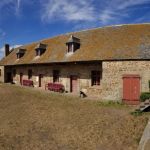
During times of peace, about 30 soldiers were stationed at the Fort National, with that number climbing to 100 soldiers during times of war. The cannons were mostly used to communicate with the city rather than fend off attackers.
The Fort is also believed to be the location of Robert Surcouf's infamous duel with 12 Prussian officers in 1871. The well-known French corsair is believed to have killed 11 Prussian officers by himself while leaving the 12th to tell the tale.
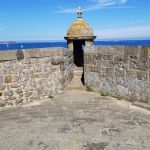
The Fort was specifically designed to resist destruction. The first important design aspect is the fact that the Fort is built into the island, using the natural terrain to create a very secure base. The second design aspect is that there are no seams in the stones. The Fort was designed in a continual pattern, as evident by the floor stones, to strengthen when it gets attacked.
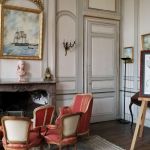
The Corsair profession began in the Middle Ages when the French King realized that he can legalize pirate activities by contracting the pirates and requiring them to share part of their booty. The King also legalize pirate activities only against countries with which the country was at war. Not only did these activities help fund the wars but they helped weaken the enemy as well. The Corsair profession was rather popular on the west coast until the late 1700s.
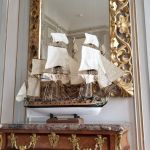
Ship design was very important during this period as the corsair ships needed to be fast and to maneuver quickly in order to take possession of the enemy ship and merchandise.
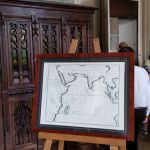
from the East Indies. The corsair invited each of the merchants one by one to a secret, private room to take the individual bids of each of the merchants.
![[Stop 10] As you take a stroll back to the old city through the park, pause to take in the nautical culture of the region.](https://www.ibafflatusdesign.space/wp-content/uploads/cache/2021/02/20200816_141150/3876972795.jpg)
